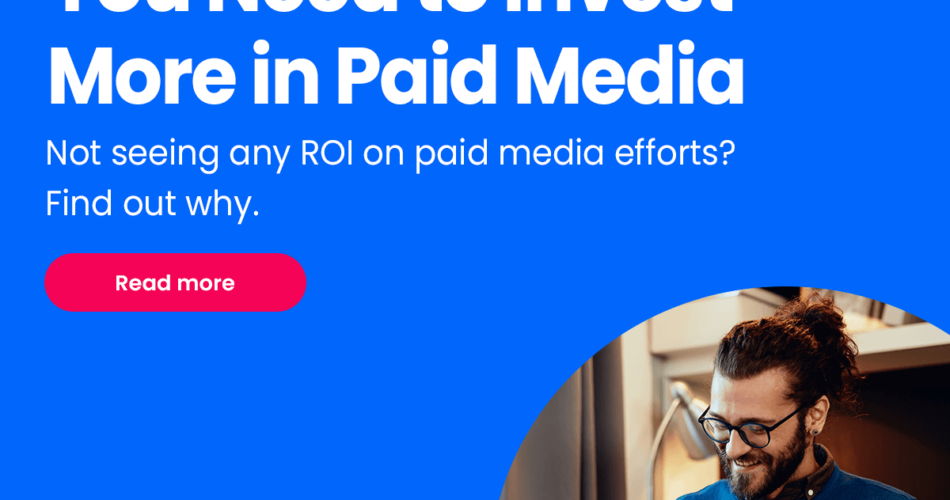If your recent B2B paid media investments have fallen short in delivering the kind of ROI you originally hoped, your first instinct might be to pump the breaks and pull back on future efforts. But new research from Nielsen suggests you should probably do the opposite. The study found the biggest indicator of paid marketing ROI is how much money marketers invest in it. And guess what? Fifty percent of them don’t spend enough.
You heard that right—if you want to see bigger results from paid media, it’s time to reevaluate your B2B media spend.
Paid Media: An Important Part of the B2B Marketing Mix
Unlike earned media (i.e., news coverage, thought leadership pieces, organic social media, and other PR efforts), paid media is exactly what it says it is: media content that comes with a price tag. Marketers shell out big bucks to get their brand messaging in front of target audiences, all in an effort to drive awareness, generate engagement, and convert top-quality leads into valuable customers. Examples of paid media include:
- Pay-per-click (PPC) advertising
- Branded content
- Digital display ads
- TV, radio, and/or print ad placements
However, marketers shouldn’t feel they have to choose one type of media over the other. Experts recommend leveraging both paid and unpaid media as part of a well-balanced B2B marketing strategy. According to researchers at the Content Marketing Institute, 81% of B2B marketers incorporate paid media into their current repertoire.

Budgeting for Paid Media
Ideally, B2B companies should spend anywhere from 1% to 9% of their annual revenue on paid media efforts. Larger brands tend to land on the lower end of that spectrum, which makes sense. Big name companies already have widespread brand recognition, so they don’t have to invest as much to increase visibility. Small to midsize B2B companies, though, experience the opposite. These organizations often budget on the higher end to break through all the digital noise and capture the attention of target customers.
Underinvesting in B2B Media Planning
As the Nielsen report uncovers, half of all marketers admit to not spending enough on media planning, especially when it comes to social. Here’s proof: despite the fact social delivers nearly twice the ROI of TV advertising, it sees just a third of the spend. And still, 43% of B2B marketers continue to underinvest in this channel.
So, what’s at the root of this issue? If you’re like most B2B marketers, you probably fall into one these three buckets:
Reason #1: The paid media landscape is tricky to navigate.
More than one-third of ad spending is off target. Imagine throwing 37% of your marketing budget out the window?
From social ads to AdWords, figuring out which channels to invest in can be a tough gig for B2B marketers. But all it takes is a little research to make your ad dollars go a long way. For example, data might uncover your target audience of mostly IT professionals spends more time consuming content on Reddit than Instagram. Or perhaps your target customers are HR employees who prefer watching webinars over reading white papers. By digging into these core audience segments, B2B marketers can create a strategic content distribution and promotion plan that utilizes preferred channels to deliver the best results.

Reason #2: It can be hard to prove the effectiveness of paid media.
Once you’ve picked the right platforms and developed relevant messaging for target prospects, it’s crucial to keep track of all engagement metrics, like click-through rate (CTR), conversion rate, and cost per acquisition (CPA). Analyzing this type of data allows marketers to focus on channels yielding the highest performance metrics.
Also, do yourself a favor and implement a marketing analytics solution to determine more precisely (and efficiently) what’s working and what’s not. There are a ton of tools out there that can make optimization a cinch and help prove B2B marketing ROI. Examples include Google Data Studio, Marketo, and LinkedIn Website Demographics.
Reason #3: Executive buy-in is a tough nut to crack.
Ok, you’ve figured out how to meet your prospects where they are, you’ve run some tests, and you’ve determined how to properly allocate paid media spend to drive the most results. But then when you go and request a bump in your budget, your CFO just laughs. What gives?
When asking for an increase in paid media spend, think, “What would my CFO do?” Most likely, he or she will want to see quantifiable proof your paid media strategy can, in fact, generate impressive returns. So, go back to your data and find your most compelling stats. Suppose your last campaign precipitated a 20% dip in your cost-per-click (CPC) rate, or maybe you conducted an operational audit to save your team thousands in unnecessary expenses. These are the kind of business cases you’ll want to present to budget decision makers in order to establish credibility with your team. With that trust in place, it’s easier to advocate for your budget request since there’s measurable proof the additional resources add value to the company’s bottom line.
Summary
No doubt, B2B media planning can be complex. Nailing the right channels and content, proving effectiveness, acquiring enough budget—it’s easy to get overwhelmed before you even start. However, once you do your due diligence to scale those roadblocks, the path to paid media ROI becomes a lot easier to navigate.
Also, bear in mind, there are a lot of seasoned professionals out there who can help tremendously in scaling your paid media ROI. Hiring a paid media specialist, outsourcing to a specialized firm, or liaising with a B2B data expert can help alleviate some of the burden, giving you and your team more time to focus on creating content that converts.
***
Want to know more tips to enhance paid media ROI? Check out our on-demand webinar, “Content that Works Hard for the Money: A Short Guide to Accelerating Your Content’s Revenue Potential.”
Source link



